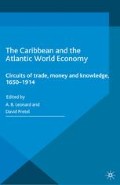Abstract
The natural flows of air and sea had a profound effect on European colonisation and exploitation of the Caribbean. Early European mariners quickly discovered that the clockwise rotation of wind and currents in the North Atlantic basin, most notably that of the Gulf Stream, greatly facilitated navigation to and from the new world. It was also learned that within the Caribbean, the prevailing currents and winds flowed to the west, sometimes reaching speeds of up to five knots. This made it easy to enter, but difficult to exit the Caribbean through the Lesser Antilles. Wooden-hulled sailing ships could leave with some difficulty via the Anegada, Mona, and Windward Passages in the Greater Antilles, though by the early sixteenth century a more desirable route was discovered through the Leeward Passage.1 This involved sailing through the Yucatan Channel to enter the Gulf Stream in the Gulf of Mexico, and to coast with it through the Straits of Florida and out into the Atlantic Ocean. Thus, virtually all ships destined to or from the Gulf of Mexico, the Caribbean, or the Atlantic side of Central and South America eventually came through Florida waters. Given the treacherous nature of the reefs and storms along this route Florida’s coastline acted as a kind of cultural sieve, culling a representative sample of this shipping in the form of thousands of sunken vessels which lie preserved on the seafloor, awaiting discovery and excavation by modern archaeologists.
Access this chapter
Tax calculation will be finalised at checkout
Purchases are for personal use only
Preview
Unable to display preview. Download preview PDF.
Notes
Smith, Roger C.: ‘Treasure ships of the Spanish Main: the Iberian–American maritime empires’, in Bass, G.F. (ed.): Ships and shipwrecks of the Americas, London: Thames & Hudson, 1988, p. 85.
Muckelroy, Keith: Maritime archaeology, Cambridge: Cambridge University Press, 1978.
Garrison, Ervan G.: ‘A diachronic study of some historical and natural factors linked to shipwreck patterns in the northern Gulf of Mexico’, in Barto, J. (ed.): Underwater archaeology: proceedings from the Society for Historical Archaeology Conference, Baltimore: Arnold, 1989, pp. 12–18
see also Garrison, Ervan G. et al: Historic shipwrecks and magnetic anomalies of the Northern Gulf of Mexico: Re-evaluation of Archaeological Resource Management Zone 1, 3 vols, New Orleans: US Department of the Interior, Minerals Management Service, 1989.
Wallerstein, Immanuel: The modern world-system, 3 vols, New York: Academic Press, 1974, 1980, 1989.
Mintz, Sidney Wilfred: ‘Time, sugar, and sweetness’, Marxist Perspectives, Winter 79/80, pp. 56–72; Sweetness and power: the place of sugar in modern history, New York: Penguin, 1986.
Champion, T. C.: Centre and periphery: comparative studies in archaeology, London: Routledge, 1995
Sanderson, Stephen K.: Civilizations and world systems: studying world-historical change, Walnut Creek: Altamira Press, 1995; Staniforth, Material Culture, p. 35.
Braudel, Fernand: Civilization and capitalism, 15th–18th century, vol. 1: the structures of everyday life, New York: Harper & Row, 1981, p. 514.
Smith, Roger C. et al: An Atlas of Maritime Florida, Tallahassee: University Press of Florida, 1997, pp. 38–9.
Meide, Chuck: A plague of ships: Spanish ships and shipbuilding in the Atlantic Colonies, sixteenth and seventeenth centuries, manuscript on file, Department of History, College of William and Mary, Williamsburg, Virginia, 2002, p. 22.
Polanyi, Karl: The great transformation: the political and economic origins of our time, Boston, MA: Beacon Press, 1957, pp. 3–19.
Dunn, Richard S.: Sugar and slaves: the rise of the planter class in the English West Indies, 1624–1713, Chapel Hill: University of North Carolina Press, 1972; Mintz, Sugar and sweetness, pp. 36–45.
Delle, James A.: An archaeology of social space: analyzing coffee plantations in Jamaica’s Blue Mountains, New York: Plenum Press, 1998, p. 46.
Murphy, R.W. (ed.): The blockade: runners and raiders, Alexandria: Time-Life Books, 1983, p. 14.
Editor information
Editors and Affiliations
Copyright information
© 2015 Chuck Meide
About this chapter
Cite this chapter
Meide, C. (2015). On the Rocks: a New Approach to Atlantic World Trade, 1520–1890. In: Leonard, A.B., Pretel, D. (eds) The Caribbean and the Atlantic World Economy. Cambridge Imperial and Post-Colonial Studies Series. Palgrave Macmillan, London. https://doi.org/10.1057/9781137432728_3
Download citation
DOI: https://doi.org/10.1057/9781137432728_3
Publisher Name: Palgrave Macmillan, London
Print ISBN: 978-1-349-68294-2
Online ISBN: 978-1-137-43272-8
eBook Packages: Palgrave History CollectionHistory (R0)

